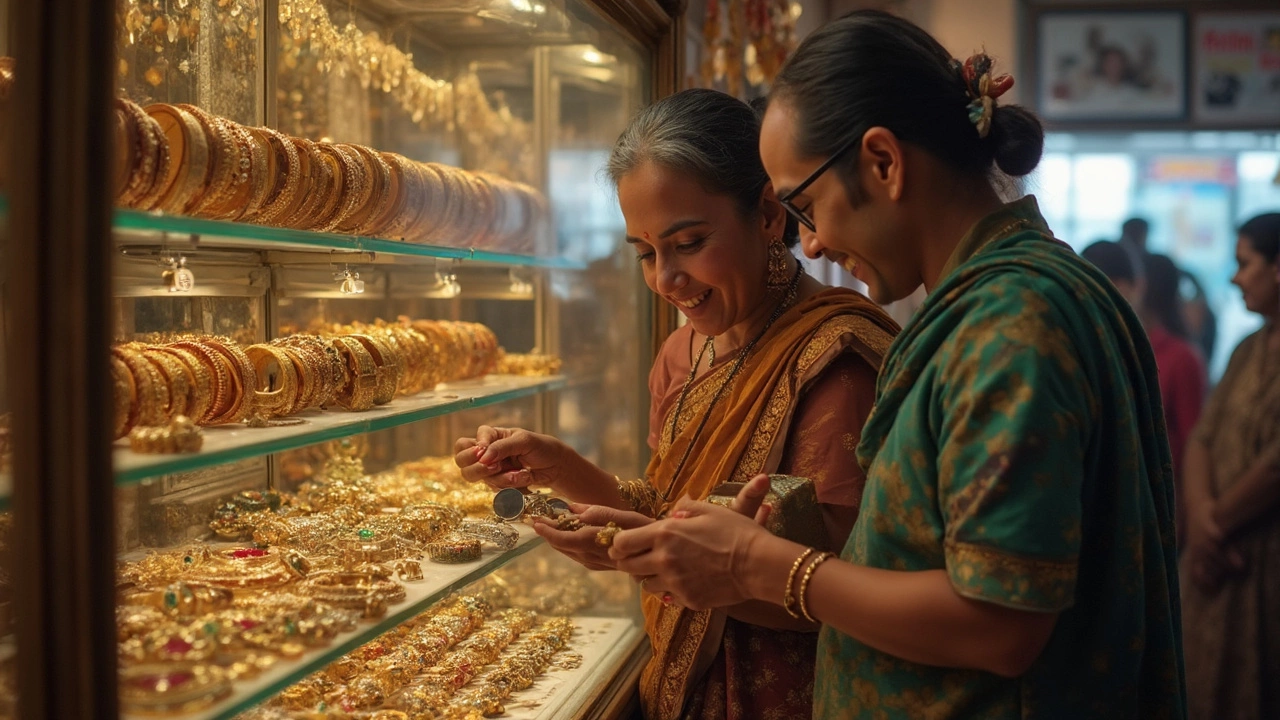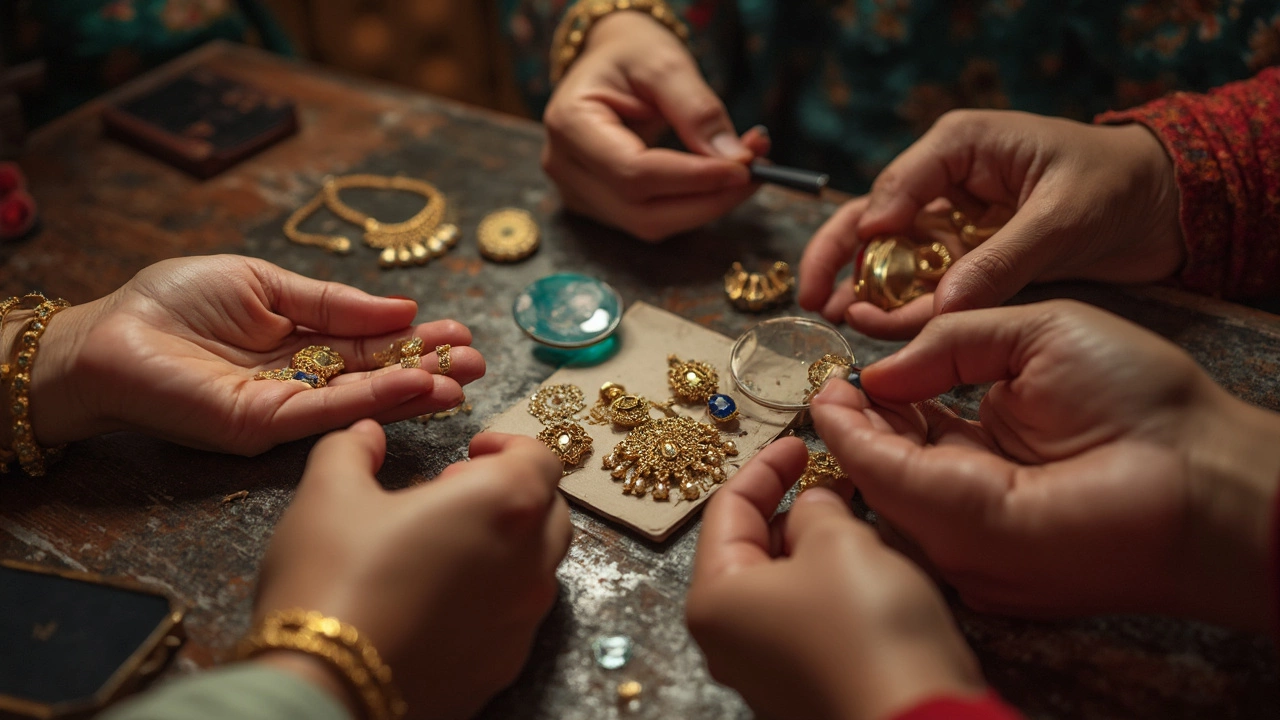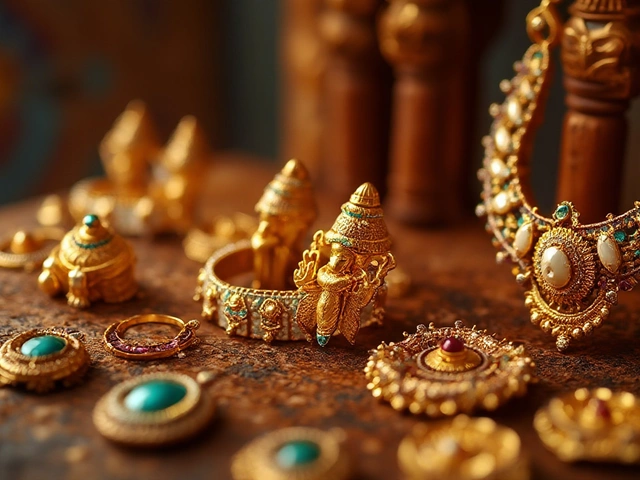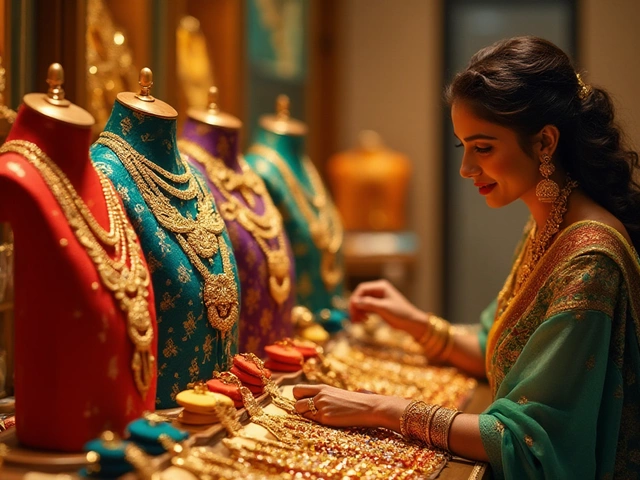
Ever walked into a pawn shop and wondered why some jewelry pieces just seem to disappear off the shelves while others gather dust? Not all antique jewelry gets a second life just because it's old. There are a few types that pawn shops can't get enough of—think gold lockets from the 1920s, Victorian brooches, or anything with a famous maker’s stamp. These pieces keep moving because buyers crave them and pawn shop owners know demand is steady.
Condition is huge. Jewelry with missing stones, broken clasps, or heavy scratches might not grab anyone’s interest, even if it’s old. Clean, complete pieces with original stones? Those are what dealers and collectors hunt for. Don’t forget, certain antique styles—like Art Deco or Edwardian—are always more popular. If you're thinking of selling, get your piece cleaned up and check if there’s a maker’s mark or stamp somewhere. That tiny symbol can bump up the price a lot.
- Top Antique Jewelry Types That Fetch High Prices
- What Pawn Shops Look for in Antique Jewelry
- Trends That Drive Quick Sales
- How to Maximize Your Jewelry's Value
Top Antique Jewelry Types That Fetch High Prices
Pawn shops always watch for certain antique jewelry that brings steady cash and moves fast. If you’re trying to figure out what really sells, here’s the breakdown of the most wanted types:
- Gold Jewelry: No surprise here. Anything gold—especially if it’s at least 14k—always gets a second look. Gold brooches, rings, and chains from past eras hold both their melt value and collectible appeal. Old gold lockets and watch chains from the Victorian or Edwardian periods are hot.
- Signed Pieces: Items with names like Tiffany & Co., Cartier, or even old Austro-Hungarian hallmarks sell quick. These brands have a loyal fan base, and buyers trust them for quality.
- Art Deco Designs (1920s-1930s): Think geometric shapes, filigree, white gold or platinum, and flashes of color from sapphires or rubies. People go crazy for this style, probably because it still looks modern today.
- Victorian & Edwardian Jewelry: Cameos, lockets, mourning rings, and anything with a bit of drama or history. If it’s got black onyx or seed pearls, all the better.
- Gemstone Rings: Real diamonds always sell, but colored stones like sapphires, emeralds, and rubies fetch high prices if they’re set in vintage or antique settings. Old European cut diamonds (think chunky sparkle) are especially in.
Condition, originality, and current trends matter too. Pawn shops won’t pay top dollar if stones are missing or pieces have been heavily repaired. They love original boxes and paperwork, but those aren’t deal-breakers if you’ve got a nice piece.
Here’s a quick look at what typically moves fast:
| Jewelry Type | Typical Price Range (USD) | Hot Era |
|---|---|---|
| Gold Victorian Rings | $200-$1,200 | 1837-1901 |
| Art Deco Brooches | $300-$2,500 | 1920s-1930s |
| Signed Designer Pieces | $500-$5,000+ | Any, especially pre-1960s |
| Antique Gemstone Pendants | $250-$1,700 | Late 1800s-early 1900s |
So, if you spot any of these in your jewelry box, you’ve probably got something pawn shops will pay up for. Real gold, recognizable brands, true antique style, and gemstones always lead the pack when it comes to fast-moving jewelry resale.
What Pawn Shops Look for in Antique Jewelry
Pawn shops aren't just trying to score any old ring or necklace—they have a system. The main thing on their mind? What pieces will actually sell fast and fetch a fair price. So, if you're thinking of selling, it's good to know what makes antique jewelry stand out to them.
First, gold always gets attention, and so does solid silver. If you've got something marked 14k, 18k, or even platinum, pawn brokers will test it and weigh it. More carats equal more cash. But it's not just about the metal—the design matters. Popular styles like Art Deco, Victorian, and Edwardian see quick turnarounds because collectors love them.
- Maker’s Marks: Look for tiny stamps on the inside of a ring or the back of a brooch. Names like Tiffany, Cartier, or even some lesser-known but quality makers instantly boost the value.
- Stones: Diamonds, sapphires, rubies, and emeralds get special treatment. If your piece has these, especially if they’re original to the setting, shops will pay more. Pawn brokers may even keep a jeweler’s loupe handy, checking for chips or cloudy stones.
- Condition: Clean and intact is king. Missing stones, obvious repairs, or noticeable scratches? That knocks value down, sometimes by half.
- Age & Provenance: Antique jewelry over 100 years old often brings better offers, especially if you have paperwork or an old receipt showing its story.
Here’s a quick look at what pawn shop buyers usually check and the impact on resale price:
| Factor | Impact on Value |
|---|---|
| Gold/Purity Stamp | +20% to 40% |
| Original Gemstones | +15% to 35% |
| Famous Maker’s Mark | +25% to 50% |
| Poor Condition | -30% to -50% |
| Provenance or History | +10% to 30% |
If you walk in with a clean, gold Art Deco ring with a certified diamond and a Cartier stamp, you’re golden—literally. But bring in a scratched-up chain with no marks, and you’ll get scrap value, nothing more. So, before you show up, check your jewelry for these features. A little homework can make a big difference at the counter.

Trends That Drive Quick Sales
One thing’s for sure—trends in antique jewelry change fast, but some styles are always in demand at pawn shops. Right now, anything Art Deco is hot. Those bold geometric shapes and colorful gemstones are climbing back up, thanks to social media and shows like "The Crown." If you walk in with a 1920s platinum ring or a flashy brooch, expect it to get snapped up.
What else is moving quickly? Victorian lockets and mourning jewelry. People want a piece with history or a cool story, and these items fit the bill perfectly. Dealer friends of mine say lockets with actual photos or hair inside fly off the shelves—even faster if the engravings are fancy or the gold is a higher karat.
Gold will always sell, especially as metal prices spike. When gold is close to $2,000 an ounce, pawn shop buyers hardly care about the style—they just want the gram weight. But when prices dip, unique design and craftsmanship matter more. Items made by known jewelers like Tiffany & Co. or Cartier? Those can sell in a day, sometimes at prices well above melt value.
Here’s a quick look at what’s trending for quick resale:
- Signed vintage pieces by famous makers (Tiffany, Cartier, Van Cleef & Arpels)
- Retro gold chains—think chunky, sturdy styles from the 1970s and 80s
- Gemstone rings—especially with emerald, sapphire, or ruby
- Mourning jewelry and lockets—especially with sentimental value
- Filigree designs from the Edwardian era
If you’re curious how fast certain styles sell at pawn shops, take a look at this snapshot from a national jewelry buyer survey in 2024:
| Jewelry Type | Avg. Days to Sell |
|---|---|
| Art Deco Rings | 5 |
| Gold Chains (1970s-80s) | 4 |
| Mourning Lockets | 7 |
| Signed Pieces | 3 |
| Generic Antique Brooches | 12 |
Keep an eye on pop culture, too. If celebrities or shows feature a special look, demand jumps the next week—no joke. It pays to know what’s trending before you bring your jewelry to the pawn shop.
How to Maximize Your Jewelry's Value
If you want to get the most cash from a pawn shop for your antique jewelry, it pays to do a little homework. Pawn brokers look at every detail, so you want your piece to stand out for all the right reasons. Here’s what helps boost your offer:
- Clean and Shine: First impressions matter. Gently clean your jewelry with a soft toothbrush and mild soap. Skip stuff like harsh chemical cleaners—those can damage antique pieces. Even a quick polish with a jewelry cloth can make gold or gemstones look richer and more appealing to buyers.
- Originality is King: Is your piece all original—no replaced stones, clasps, or settings? That’s a goldmine. Original parts fetch much higher resale value than anything that’s been fixed with modern bits or mismatched stones.
- Find the Maker’s Mark: Look for stamps or signatures hidden inside the band or on the back of lockets and brooches. Marks from well-known brands or designers (think Tiffany, Cartier, or even lesser-known but reputable Victorian silversmiths) always boost value.
- Documentation Helps: If you have an old receipt, appraisal, or a certificate, bring that along. Even a family letter about the piece’s history can sometimes help a broker believe in its authenticity. Original boxes or packaging can also increase price, especially for luxury names.
- Know the Trends: Pieces in popular styles—like Art Deco or Edwardian—tend to move fast and at better prices. Pawn shop owners follow trends just like regular jewelry stores do.
- Get a Second Opinion: Before you accept an offer, check similar sales online. Sites like eBay (look for SOLD listings) or Reverb for certain vintage pieces help you gauge what people are willing to pay. This puts you in a stronger position to negotiate with the pawnbroker.
Want to know what really bumps up the value? Here’s a quick look at where the money usually comes from when pawn shops price out your jewelry:
| Factor | Impact on Value |
|---|---|
| Gold content (karat and weight) | 40-50% |
| Gemstone quality (clarity, size, origin) | 20-25% |
| Brand/Designer marks | 15-20% |
| Age and style | 10-15% |
| Condition | up to 10% |
Sometimes, even pieces that aren't super rare fetch higher prices because they're still in demand for their gold or gems. Don't just accept the first offer you get—having a little know-how goes a long way toward getting top dollar for your antique jewelry at the pawn shop.




